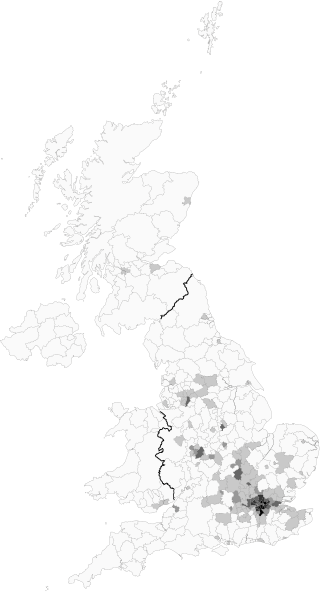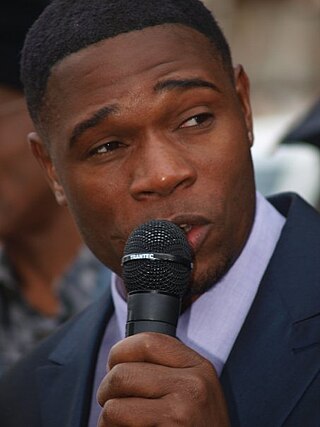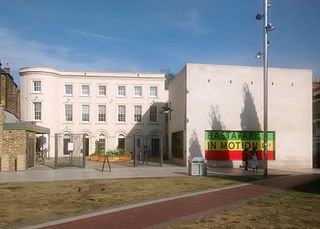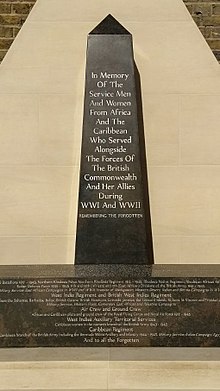
Whittington Hospital is a district general and teaching hospital of UCL Medical School and Middlesex University School of Health and Social Sciences. Located in Upper Holloway, it is managed by Whittington Health NHS Trust, operating as Whittington Health, an integrated care organisation providing hospital and community health services in the north London boroughs of Islington and Haringey. Its Jenner Building, a former smallpox hospital, is a Grade II listed building.

Black British people are a multi-ethnic group of British citizens of either African or Afro-Caribbean descent. The term Black British developed in the 1950s, referring to the Black British West Indian people from the former Caribbean British colonies in the West Indies now referred to as the Windrush Generation and people from Africa, who are residents of the United Kingdom and are British.

British African-Caribbean people are an ethnic group in the United Kingdom. They are British citizens whose ancestry originates from the Caribbean or they are nationals of the Caribbean who reside in the UK. There are some self-identified Afro-Caribbean people who are multi-racial. The most common and traditional use of the term African-Caribbean community is in reference to groups of residents continuing aspects of Caribbean culture, customs and traditions in the UK.
Val Irvine McCalla was a Jamaican accountant and media entrepreneur who settled in Britain in 1959. He is best known as the founder of The Voice, a British weekly newspaper aimed at the Britain's black community, which he established in 1982 as a voice for the British African-Caribbean community. He was honoured as a pioneering publisher for the community, but also faced critics who deemed him sensationalistic.

The Welsh National War Memorial is situated in Alexandra Gardens, Cathays Park, Cardiff. The memorial was designed by Sir Ninian Comper and unveiled on 12 June 1928 by the Prince of Wales. The memorial commemorates the servicemen who died during the First World War and has a commemorative plaque for those who died during the Second World War, added in 1949.

HMT Empire Windrush, originally MV Monte Rosa, was a passenger liner and cruise ship launched in Germany in 1930. She was owned and operated by the German shipping line Hamburg Süd in the 1930s under the name Monte Rosa. During World War II she was operated by the German navy as a troopship. At the end of the war, she was taken by the British Government as a prize of war and renamed the Empire Windrush. In British service, she continued to be used as a troopship until March 1954, when the vessel caught fire and sank in the Mediterranean Sea with the loss of four crewmen. HMT stands for "His Majesty's Transport" and MV for "Motor Vessel".
Nubian Jak is a multi-award-winning board game, introduced in 1994, that combines questions on historical facts with pop trivia, to highlight some of the achievements by people of colour globally.

Jak Beula Dodd, commonly known as Jak Beula, is a British entrepreneur and cultural activist of Caribbean heritage, who is best known for inventing the board game Nubian Jak and designing the African and Caribbean War Memorial. He is also a musician, social-worker, and former model. Beula has received recognition for campaigning to commemorate black history in the UK. He is the founder and chief executive of the Nubian Jak Community Trust, which since 2006 has been memorializing the contributions of African-Caribbean people in Britain.

Black Cultural Archives (BCA) is an archive and heritage centre in Brixton, London, devoted to the histories of people of African and Caribbean descent in Britain. Also known as BCA, it was founded in 1981, by educationalist and historian Len Garrison and others. BCA's mission is to record, preserve and celebrate the history of people of African descent in Britain. The BCA's new building in Brixton, opened in 2014, enables access to the archive collection, provides dedicated learning spaces and mounts a programme of exhibitions and events.

Lambeth Town Hall, also known as Brixton Town Hall, is a municipal building at the corner of Brixton Hill and Acre Lane, Brixton, London. The town hall, which is the headquarters of Lambeth London Borough Council, is a Grade II listed building.
Nubian Jak Community Trust (NJCT) is a commemorative plaque and sculpture scheme founded by Jak Beula that highlights the historic contributions of Black and minority ethnic people in Britain. The first NJCT heritage plaque, honouring Bob Marley, was unveiled in 2006 after "two years of research and behind the scenes negotiating". The scheme has been run and managed by the not-for-profit organization Nubian Jak Trust Ltd since August 2016, with a remit to commemorate and celebrate the diverse history of modern Britain. Its objectives include the promotion of social equality and to encourage activities that promote cultural diversity in society.

Constance Winifred Mark, MBE, BEM was a Jamaican-born community organiser and activist. She served as a medical secretary in the Auxiliary Territorial Service in World War II. After moving to England in the early 1950s, she became an activist for West Indians in London, after being denied her British Empire Medal. She worked to gain recognition for Black service personnel who were overlooked for their services and co-founded the Mary Seacole Memorial Association to bring recognition to the accomplishments of the noted Jamaican nurse.

Windrush Square is an open public space in the centre of Brixton, South London, occupying an area in front of the Brixton Tate Library. After changing its name to Tate Gardens, it was again retitled and given its current moniker in 1998. The square was renamed to recognise the important contribution of the African Caribbean community to the area, marking the 50th anniversary of the arrival of the HMT Empire Windrush. It was the Windrush that in 1948 brought to the United Kingdom from Jamaica the first large group of post-war West Indian migrants, who on arrival were temporarily housed less than a mile away from Coldharbour Lane in Brixton.
Patrick Philip Vernon is a British social commentator and political activist of Jamaican heritage, who works in the voluntary and public sector. He is a former Labour councillor in the London Borough of Hackney. His career has been involved with developing and managing health and social care services, including mental health, public health, regeneration and employment projects. Also a film maker and amateur cultural historian, he runs his own social enterprise promoting the history of diverse communities, as founder of Every Generation and the "100 Great Black Britons" campaign. He is also an expert on African and Caribbean genealogy in the UK. He was appointed a Clore Fellow in 2007, an Officer of the Order of the British Empire (OBE) in the 2012 Birthday Honours for "services to the Reduction of Health Inequalities for Ethnic Minorities", and in 2018 was awarded an honorary doctorate from the University of Wolverhampton.
Neil Emile Elias Kenlock is a Jamaican-born photographer and media professional who has lived in London since the 1960s. During the 1960s and 1970s, Kenlock was the official photographer of the British Black Panthers, and he has been described as being "at the forefront of documenting the black experience in the UK". Kenlock was co-founder of Choice FM, the first successful radio station granted a licence to cater for the black community in Britain.
Beverley Bryan is a Jamaican educationist and retired academic who was a professor of language education at the University of the West Indies in Mona. Settling in Britain with her parents in the late 1950s, she went on to become a founding member of the Brixton Black Women's Group and co-authored the 1985 book The Heart of the Race: Black Women's Lives in Britain.
Windrush Day was introduced in June 2018 on the 70th anniversary of the Windrush migration. Though Windrush Day is not a bank holiday in the United Kingdom, it is an observed day. It is on 22 June. It was instituted following a successful campaign led by Patrick Vernon.
Arthur Torrington CBE is a Guyanese-born community advocate and historian who is Director and co-founder of the London-based Windrush Foundation, a charity that since 1996 has been working to highlight the contributions to the UK of African and Caribbean peoples, "to keep alive the memories of the young men and women who were among the first wave of post-war settlers in Britain", and to promote good community relations. The organization commemorates in its name the Empire Windrush, the ship that on 22 June 1948 docked at Tilbury bringing the first significant group of Caribbean migrants to Britain, including Sam King, who with Torrington established the Windrush Foundation.

Custard Apple (Annonaceae), Breadfruit (Moraceae) and Soursop (Annonaceae) are three sculptures by Veronica Ryan that stand on Narrow Way, near St Augustine's Tower in Hackney, London. They were commissioned as a memorial to the Windrush generation of British African-Caribbean people who immigrated to the United Kingdom in the wake of World War II.
Veronica Ryan’s Custard Apple (Annonaceae), Breadfruit (Moraceae) and Soursop (Annonaceae) is the first permanent public sculpture by a black female artist in the UK. — Create London












